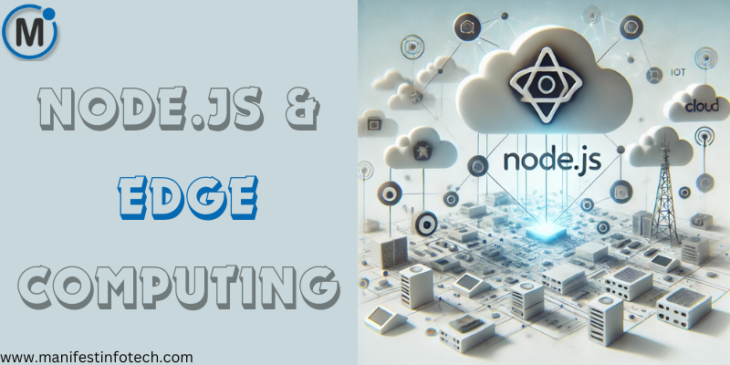
In the ever-evolving landscape of computing, edge computing has emerged as a game-changer, bringing processing power closer to data sources. At the same time, Node.js has continued to thrive as a lightweight, efficient runtime for building fast, scalable applications. But how do these two technologies intersect? Let’s explore why Node.js is an excellent fit for edge computing and how it enhances real-time data processing.
What is Edge Computing?
Edge computing refers to processing data closer to its source instead of relying on centralized cloud servers. This approach reduces latency, improves speed, and enhances security by minimizing the amount of data transmitted over networks. Edge computing is crucial for IoT (Internet of Things) devices, autonomous vehicles, smart cities, and real-time analytics applications.
Why Node.js is Ideal for Edge Computing
Node.js is widely used in edge computing environments due to its event-driven, non-blocking architecture. Here are some key reasons why Node.js excels in edge computing:
1. Lightweight and Fast Execution
Edge devices have limited computational resources. Node.js’s lightweight nature makes it an ideal choice, ensuring applications run smoothly with minimal hardware requirements.
2. Asynchronous Processing
Edge computing often involves handling multiple data streams simultaneously. Node.js’s non-blocking, asynchronous nature enables efficient real-time data processing without slowing down the system.
3. Low Latency for Real-Time Applications
One of the primary goals of edge computing is to reduce latency. Node.js, with its high-speed V8 JavaScript engine and event-driven model, ensures faster response times, making it perfect for applications requiring real-time processing.
4. Scalability and Microservices Architecture
Node.js supports microservices and containerized deployments, making it easier to scale edge applications. By deploying Node.js services across distributed edge nodes, organizations can efficiently handle growing workloads.
5. Compatibility with IoT and APIs
Node.js is widely used in IoT development due to its ability to communicate efficiently with various APIs and protocols such as MQTT, WebSockets, and HTTP. This makes it an excellent choice for integrating with edge computing devices.
Real-World Use Cases of Node.js in Edge Computing
1. Smart Homes and IoT Devices
Node.js powers many IoT devices by processing data at the edge, reducing dependence on cloud servers. Smart thermostats, security systems, and voice assistants utilize Node.js for quick decision-making.
2. Autonomous Vehicles
Self-driving cars require real-time data processing for navigation and obstacle detection. Node.js, in combination with edge computing, enables rapid decision-making and improves safety.
3. Retail and Inventory Management
Retail stores use edge computing with Node.js to track inventory levels, analyze customer behavior, and optimize supply chains in real time.
4. Healthcare and Remote Patient Monitoring
Wearable devices and medical sensors use Node.js to process patient data on the edge, providing instant health insights without relying on cloud processing.
Challenges and Considerations
While Node.js offers many advantages in edge computing, there are some challenges to address:
Security Risks: Processing data at the edge can increase security vulnerabilities. Implementing encryption and secure communication protocols is essential.
Resource Constraints: Some edge devices have extremely limited resources, requiring optimization techniques to ensure smooth operation.
Data Synchronization: Managing data consistency between edge devices and central servers can be complex.
Conclusion
Node.js and edge computing form a powerful combination for building efficient, real-time, and scalable applications. With its lightweight architecture, non-blocking processing, and compatibility with IoT technologies, Node.js is a natural fit for edge environments. As edge computing continues to grow, leveraging Node.js can help businesses unlock new opportunities in performance, security, and real-time analytics.
Stay ahead of the curve by integrating Node.js into your edge computing strategy and revolutionize the way data is processed closer to the source!
If you are looking for any services related to Website Development, App Development, Digital Marketing and SEO, just email us at nchouksey@manifestinfotech.com or Skype id: live:76bad32bff24d30d
𝐅𝐨𝐥𝐥𝐨𝐰 𝐔𝐬:
𝐋𝐢𝐧𝐤𝐞𝐝𝐢𝐧: linkedin.com/company/manifestinfotech
𝐅𝐚𝐜𝐞𝐛𝐨𝐨𝐤: facebook.com/manifestinfotech/
𝐈𝐧𝐬𝐭𝐚𝐠𝐫𝐚𝐦: instagram.com/manifestinfotech/
𝐓𝐰𝐢𝐭𝐭𝐞𝐫: twitter.com/Manifest_info
#NodeJS #EdgeComputing #IoT #RealTimeProcessing #CloudComputing #JavaScript #Microservices #TechInnovation